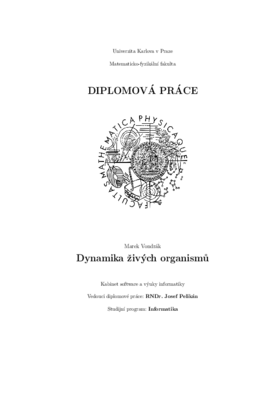Dynamika živých organismů
Dynamika živých organismů
diplomová práce (OBHÁJENO)

Zobrazit/
Trvalý odkaz
http://hdl.handle.net/20.500.11956/3152Identifikátory
SIS: 40307
Katalog UK: 990008349620106986
Kolekce
- Kvalifikační práce [11973]
Autor
Vedoucí práce
Oponent práce
Kavan, Ladislav
Fakulta / součást
Matematicko-fyzikální fakulta
Obor
Softwarové systémy
Katedra / ústav / klinika
Katedra softwarového inženýrství
Datum obhajoby
6. 2. 2006
Nakladatel
Univerzita Karlova, Matematicko-fyzikální fakultaJazyk
Angličtina
Známka
Výborně
Počítačová animace artikulovaných postav je jedna z nejzajzajímavějších a nejvíce se rozvíjejících oblastí moderní počítačové grafiky. Cílem této práce je seznámit čtenáře s teorií simulace tuhých těles s omezeními, která je následně použita ke konstrukci obecného simulátoru tuhých těles s omezeními a třením a animační knihovny pro artikulované postavy. Postavy jsou reprezentovány soustavami tuhých těles (segmentů) propojených klouby a jejich pohyb určen dynamikou příslušných segmentů. Dodatečná omezení, předepisující např. požadované úhly v kloubech nebo pozice vybraných bodů na povrchu segmentů, umožňují řídit pohyb postav. Bohaté interaktivní demonstrační příklady předvádí vlastnosti samotného simulátoru a možnosti animační knihovny pro zpracování motion capture dat (přehrávání animací, přizpůsobování animací externím vlivům, mapování "syrových" motion capture dat na pohyb segmentů, atd.).
The computer animation of articulated figures is one of the most interesting and the most developing areas of the modern computer graphics. The goal of this thesis is to get the reader acquainted with the theory of constrained rigid body simulation, which is subsequently used to construct a generic rigid body simulator with constraints and friction and the figure library suitable for the animation of articulated human-like figures. Articulated figures are represented by sets of rigid bodies (segments) connected by joints and their motion is determined by the dynamics of the corresponding segments. Additional constraints, specifying e.g. desired angles at joints or the positions of selected sites on the surface of the figure segments, allow to control the figure motion. A rich set of interactive demonstration examples presents the features of the actual simulator and the capabilities of the figure library to process motion capture data (replay motion capture data, adapt the data to external influences, map the "raw" motion capture data to the motion of figure segments, etc).
